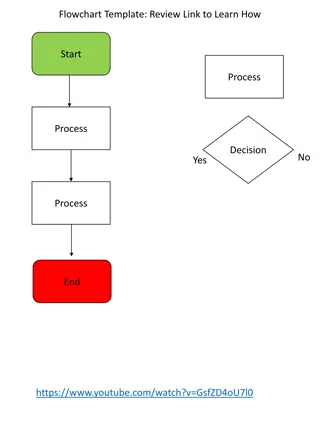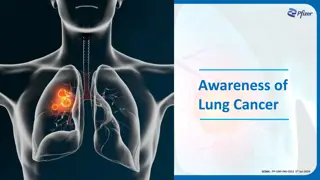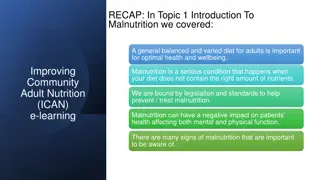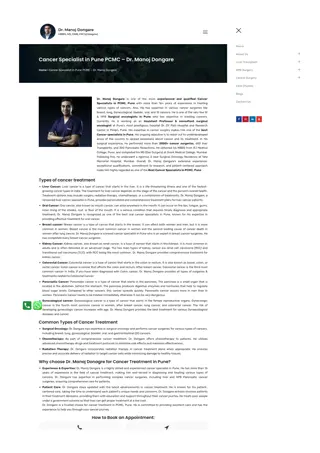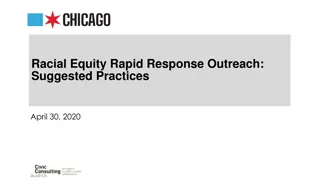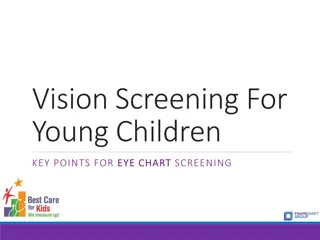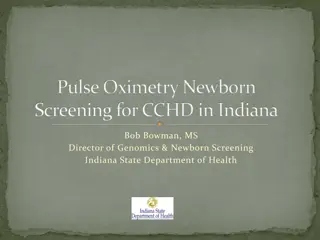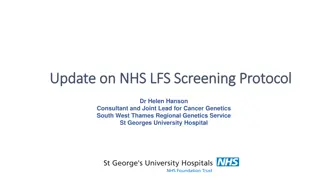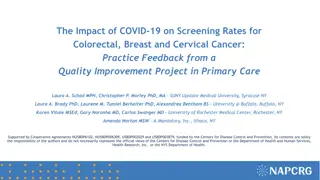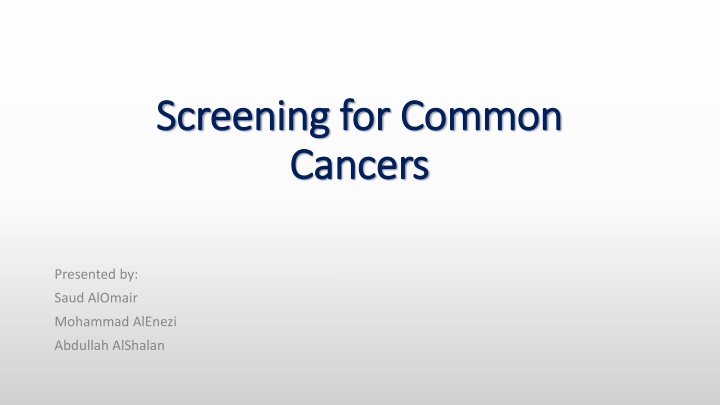
Screening and Surveillance for Common Cancers: Important Risk Factors & Methods
Learn about the essential risk factors for breast, cervical, prostate, and colorectal cancers and the best screening methods. Understand the role of screening and surveillance in early detection and prevention. Find out how to reduce the risk of developing colorectal cancer through lifestyle choices.
Download Presentation

Please find below an Image/Link to download the presentation.
The content on the website is provided AS IS for your information and personal use only. It may not be sold, licensed, or shared on other websites without obtaining consent from the author. If you encounter any issues during the download, it is possible that the publisher has removed the file from their server.
You are allowed to download the files provided on this website for personal or commercial use, subject to the condition that they are used lawfully. All files are the property of their respective owners.
The content on the website is provided AS IS for your information and personal use only. It may not be sold, licensed, or shared on other websites without obtaining consent from the author.
E N D
Presentation Transcript
Screening for Screening for Common Cancers Cancers Common Presented by: Saud AlOmair Mohammad AlEnezi Abdullah AlShalan
Q1) Which of the following are the most important and clinically useful risk factors for breast cancer? . A. Fibrocystic disease, age, and gender. B. Cysts, family history in immediate relatives, and gender. C. Age, gender, and family history in immediate relatives. D. Obesity, nulliparity, and alcohol use
Q2) Which one of the following is the best screening method for breast cancer in a 45 year old lady ? A. Clinical breast examination B. Ultrasound C. Self Breast examination D. Mammography
Q3) The most important risk factor regarding cervical cancer is ? A. HPV (16, 18) infection. B. HPV (31, 32, 33) infection. C. Family history. D. Smoking
Q4) What is the race most associated with prostate cancer? A. Indians B. Asians C. African Americans D. European Americans
Q5) Which of the following could reduce the risk of developing colorectal cancer? A. Physical exercise B. Increasing dietary fibers C. Avoiding NSAIDs D. All the above
Screening and Surveillance Screening: involves one or more tests performed to identify whether a person with no symptoms has a disease or condition that may lead to cancer. The goal is to identify the potential for disease or the condition early when it is easier to prevent or cure. Surveillance: involves testing people who have previously had cancer or are at increased risk. Because their chance of having cancer is higher, more extensive or more frequent tests are recommended.
Criteria for screening Knowledge of disease: The condition should be important. There must be a recognizable latent or early symptomatic stage. The natural course of the condition, including development from latent to declared disease, should be adequately understood. Knowledge of test: Suitable test or examination. Test acceptable to population. Case finding should be continuous. Treatment for disease: Accepted treatment for patients with recognized disease. Facilities for diagnosis and treatment available. Agreed policy concerning whom to treat as patients. Cost considerations:
Breast Cancer Breast Cancer
Epidemiology It is the most commonly diagnosed cancer in women It is the second leading cause of death among women In 2010, there were 1,643,000 estimated new cases of breast cancer worldwide 60% of breast cancer deaths, occur in women in developing countries Worldwide, there were over 508,000 breast cancer deaths in women in 2011
Estrogen role in breast cancer Estrogen is essential for the normal functioning of a woman's reproductive system and for normal breast development. Lifetime exposure to estrogen is thought to increase a woman's risk for breast cancer Estrogen may be implicated in breast cancer risk because of: 1) its role in stimulating breast cell division. 2) its work during the critical periods of breast growth and development. 3) its effect on other hormones that stimulate breast cell division. 4) its support of the growth of estrogen-responsive tumors.
Risk Factors (Non modifiable) Gender (100 times more common in females) Age (increase with age) Race (overall more in whites) Menstrual periods Family history Genetic factor Dense breast tissue
Risk Factors (Modifiable) Parity Birth controls Hormone therapy after menopause Breastfeeding Alcohol consumption Obesity Physical inactivity(a study showed a 2.5 hour per week of brisk walking reduce breast cancer risk by 18%)
Screening for breast cancer Mammogram: is an X-ray of the breast. Mammograms are the best way to find breast cancer early, when it is easier to treat and before it is big enough to feel or cause symptoms. Having regular mammograms can lower the risk of dying from breast cancer. It is recommended for women over the age of 40 to do mammogram yearly
Clinical Breast Exam (CBE): A clinical breast exam is an examination by a doctor or nurse, who uses their hands to feel for lumps or other changes. Recommended to be done every 3 years for women in their 20s and 30s and every year for women 40 and over
Breast Self Exam (BSE): A breast self-exam is when a women checks her own breasts for lumps, changes in size or shape of the breast, or any other changes in the breasts or armpit. Women should know how their breasts normally look and feel and report any breast change promptly to their health care provider. Breast self-exam (BSE) is an option for women starting in their 20s.
Benefits and harms of breast cancer screening Mammogram Benefits: Decrease in breast cancer mortality A study showed that for women aged 40 to 74 years, screening with mammography has been associated with a 15% to 20% relative reduction in mortality due to breast cancer. Harms: Over diagnosis and Resulting in Treatment of Insignificant Cancers False-Positives with Additional Testing and Anxiety On average, 10% of women will be recalled from each screening examination for further testing, and only 5 of the 100 women recalled will have cancer False-Negatives with False Sense of Security Radiation-Induced Breast Cancer Theoretically, annual mammograms in women aged 40 to 80 years may cause up to one breast cancer per 1,000 women
Clinical Breast Examination Benefits: has not been tested independently it was used in conjunction with mammography and showed equivalent benefit for both modalities Harms: False-Positives with Additional Testing and Anxiety False-Negatives with Potential False Reassurance
Breast Self Examination Benefits: Breast self examination has been compared to usual care (no screening activity) and has not been shown to reduce breast cancer mortality Harms: Based on solid evidence, formal instruction and encouragement to perform BSE leads to more breast biopsies and diagnosis of more benign breast lesions.
Cervical Cancer Cervical Cancer
Epidemiology Worldwide, cervical cancer is both the fourth most common cause of cancer, and fourth most common cause of deaths from cancer in women More than one-half of women who develop cervical cancer have not been screened appropriately It is estimated that over 6 million people are infected with genital HPV in the United States each year Approximately 80% of cervical cancers occur in developing countries The majority of cases are squamous cell carcinoma, and adenocarcinomas are less common
Cervical Cancer in Saudi Arabia Saudi Arabia has a population of 6.51 millions women ages 15 years and older who are at risk of developing cervical cancer Cervical cancer ranks as the 11th most frequent cancer among women in Saudi Arabia, and the 8th most frequent cancer among women between 15 and 44 years of age Current estimates indicate that every year 152 women are diagnosed with cervical cancer and 55 die from the disease in Saudi Arabia
Risk Factors HPV (16, 18) HPV Exposure HPV (31,32,33) less important Smoking Oral Contraceptives Parity 15% higher in women who have had 1 full-term pregnancy 64% higher in those with 7+ full-term pregnancies Age at first full-term pregnancy 77% higher in those under 17 years old Immunosuppression Family History (First degree relative) squamous cell carcinoma risk is 74-80% adenocarcinoma risk is 39-69% Age (25 65)
HPV Vaccination Gardasil is used in the national NHS cervical cancer vaccination program. Gardasil protects against HPV type (6,11,16 and 18) The incidence and mortality rates are related to the presence of screening and HPV vaccination programs
1-Advisory Committee on Immunization Practices 2-The American Congress of Obstetricians and Gynecologists 3-American Academy of Family Physicians 4-American College Health Association
Special Cases for HPV Vaccine Immunosuppression Can be vaccinated (not live) Lactating women Can receive vaccine Pregnant women Should be initiated after the pregnancy If found pregnant after the initiation of the vaccine, completion should be delayed until after the pregnancy
Benefits Prevent anal, vulvar, and vaginal cancers and pre-cancers linked to these types of HPV Prevent genital and anal warts Issues Side effects Research show that the vaccine is not beneficial for previously infected patients
Screening for Cervical Cancer Rates of cervical cancer have fallen by approximately 75% since the introduction of Pap screening programs The five-year survival rate for women with invasive cervical cancer is 68%. When detected at an early stage, the five-year survival rate is 91%. Pap smear is the most common screening test for cervical cancer, however liquid based-cytology is the standard screening method in the UK. Liquid based cytology is more specific and more sensitive than the conventional Pap test.
Cotesting Cotesting is using pap test and HPV test as screening for cervical cancer. There is a research that suggests testing HPV alone as screening for cervical cancer. The research followed women with negative pap test and negative HPV for three years, to see how many develop cervical cancer 20 out of 100,000 developed cervical cancer following a negative Pap test 11 out of 100,000 developed cervical cancer following a negative HPV test.
Age group (years) Frequency of screening 25 First invitation 25 - 49 3 yearly 50 - 64 5 yearly 65+ Only screen those who have not been screened since age 50 or have had recent abnormal tests
Benefits of screening Decrease the incidence of cervical cancer Decrease the cervical cancer mortality Harms of screening Over diagnosis Cost anxiety
Prostate Cancer Prostate Cancer
Epidemiology Prostate cancer is the second most common cancer in men worldwide Estimated 1,100,000 cases and 307,000 deaths in 2012 The lifetime risk of prostate cancer for men living in the United States is estimated to be approximately one in six
Age-standardized incidence of prostate cancer (per dlrow eht ni ) 100,000 29.0 Africa Congo 16.6 Kenya 7.5 Senegal 38.0 Uganda 27.4 Zimbabwe 78.2 North America Canada 124.8 US 107.8 US, White 185.4 US, Black 1.7 Asia China 3.0 Taiwan 47.5 Israel 12.6 Japan 7.6 Korea 4.5 Thailand 71.4 Europe Austria 100.1 Austria, Tyrol 66.4 Austria, Vorarlberg 59.3 France 34.0 Hungary 75.2 Iceland 81.8 Norway 35.9 Spain 90.9 Sweden 77.3 Switzerland 52.2 UK 76.0 Oceania Australia 100.9 New Zealand
Autopsy prevalence of prostate cancer in the world 19 28 29 30 Age US White US Black Japan Spain Greece Hungary 3 3 30 - 21 8 8 0 4 0 0 40 - 31 31 31 20 9 0 27 50 - 41 37 43 13 14 3 20 60 - 51 44 46 22 24 5 28 70 - 61 65 70 35 32 14 44 80 - 71 83 81 41 33 31 58 90 - 81 48 40 73
Age-standardized mortality of prostate cancer (per dlrow eht ni ) 100,000 22.6 Africa South Africa 32.5 Uganda 6.5 Senegal 23.5 Zimbabwe 1.0 Asia China 13.4 Israel 5.7 Japan 18.4 Europe Austria 18.2 France 15.8 Germany 18.4 Hungary 23.0 Iceland 12.2 Italy 28.4 Norway 14.9 Spain 27.7 Sweden 17.9 UK 15.8 North America US 16.6 Canada 17.7 Oceania Australia 20.3 New Zealand
Risk Factors Age Race Genetics (BRCA1 BRCA2) Family history Smoking
Screening for Prostate Cancer The standard screening method is PSA level, however it is not specific. Digital rectal exam is another screening test done by the doctor to detect enlargement and masses.
PSA There is no specific normal or abnormal level of PSA in the blood PSA levels of 4.0 ng/mL and lower were considered normal. However, more recent studies have shown that some men with PSA levels below 4.0 ng/mL have prostate cancer and that many men with higher levels do not have prostate cancer
PSA Age PSA cut-off (ng/ml) 50-59 3 60-69 4 70 and over > 5
PSA vs Digital rectal exam An American multicenter clinical trail compared the two methods in 6,630 men The results showed that 15% of the men had a PSA level of greater than 4 micrograms/l, 15% had a suspicious digital rectal examination and 26% had suspicious findings on either or both tests. Of 1,167 biopsies performed cancer was detected in 264. PSA detected significantly more tumors (82%, 216 of 264 cancers) than digital rectal examination (55%, 146 of 264, p = 0.001).
Detecting prostate cancer early may not reduce the chance of dying from prostate cancer The PSA test may give false-positive or false- negative results
Colorectal Cancer Colorectal Cancer
Epidemiology Colorectal cancer is the third most common cancer worldwide and the fourth most common cause of death Accounts for over 9% of all cancer incidence Has geographical variation Mainly a disease of developed countries Sex: male = female
Risk Factors Modifiable risk factors: Nutrition and diet Physical inactivity and obesity Smoking Alcohol intake Non-modifiable: Age Personal history of adenomatous polyps IBD Family history of colorectal cancer or adenomatous polyps
Screening The main aim of screening is discovering precancerous polyps to prevent progression to cancer Should begin at the age of 50 in average risk individuals Screening methods include: Colonoscopy Sigmoidoscopy CT colonography Fecal occult blood test


